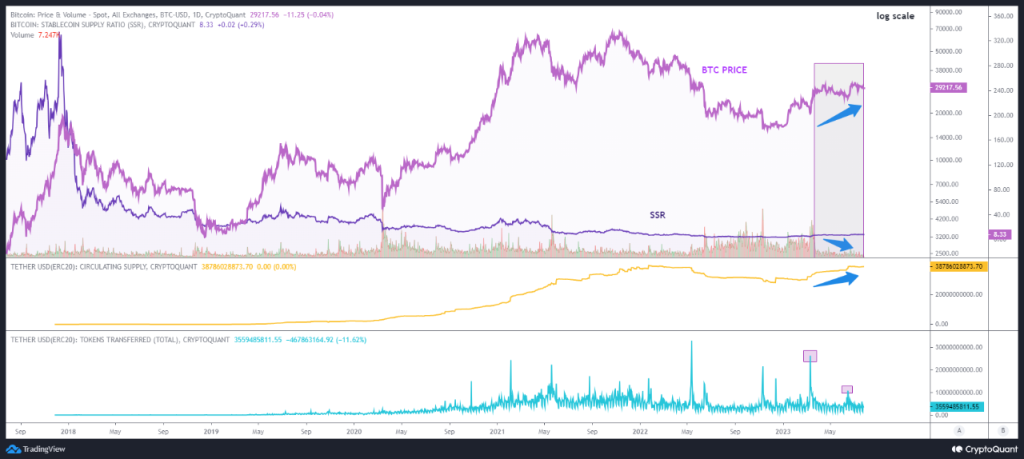In this article, we delve into the critical concept of the Stablecoin Supply Ratio (SSR) and its profound impact on the Bitcoin (BTC) market trends. We explore how this often overlooked metric plays a crucial role in influencing market sentiment, demand-supply dynamics, and ultimately, the price movements of BTC.
What is the Stablecoin Supply Ratio (SSR)?
The Stablecoin Supply Ratio (SSR) is a vital metric that measures the relationship between the total market capitalization of Bitcoin and the total market capitalization of stablecoins. Essentially, it quantifies the amount of stablecoins held in the market in relation to the value of Bitcoin. The formula for SSR can be represented as:
SSR = Total Market Cap of Stablecoins / Total Market Cap of BitcoinWhen SSR is low, it indicates that there is a significant amount of stablecoins available relative to Bitcoin’s value. Conversely, a high SSR implies that the supply of stablecoins is relatively low compared to Bitcoin’s market capitalization.

The SSR-BTC Market Trend Relationship
1. SSR as a Market Sentiment Indicator
The SSR serves as an essential market sentiment indicator. When the SSR is high, it suggests that a substantial portion of traders and investors are holding stablecoins, indicating a bearish sentiment towards Bitcoin. In contrast, a low SSR implies a bullish sentiment as more market participants have invested in Bitcoin rather than stablecoins.
2. SSR and Demand-Supply Dynamics
The SSR plays a critical role in influencing the demand and supply dynamics of Bitcoin. A high SSR signifies that traders are hesitant to enter the Bitcoin market, resulting in decreased demand and potential price stagnation. On the other hand, a low SSR attracts more investors, leading to increased demand and potentially driving BTC’s price higher.
3. SSR’s Impact on Price Movements
The Stablecoin Supply Ratio has a direct impact on Bitcoin’s price movements. During periods of high SSR, the price of BTC may experience resistance, making it challenging for it to surpass certain price levels. Conversely, a low SSR can lead to significant price breakthroughs, as the increased demand from investors drives the price upward.
Factors Affecting SSR
Several factors influence the SSR and, consequently, the BTC market trends:
1. Market Sentiment
Market sentiment heavily influences the SSR. Bullish sentiment encourages investors to move funds from stablecoins to BTC, reducing the SSR. Conversely, bearish sentiment prompts investors to flock to stablecoins, increasing the SSR.
2. Regulatory Developments
Changes in regulations can impact the SSR. If regulatory uncertainty increases, investors may opt for stablecoins as a safer haven, driving the SSR higher.
3. Market Volatility
Higher volatility in the cryptocurrency market can lead to increased SSR as investors seek shelter in stable assets.
Conclusion
In conclusion, understanding the significance of the Stablecoin Supply Ratio (SSR) is crucial for predicting BTC market trends accurately. The SSR acts as a barometer of market sentiment, demand-supply dynamics, and price movements. Monitoring changes in the SSR and its influencing factors empowers traders and investors with valuable insights, enabling them to make well-informed decisions in the dynamic world of cryptocurrencies.
We strive to equip our readers with comprehensive knowledge that empowers them to navigate the market with confidence and seize lucrative opportunities. Remember, the SSR is not merely a metric; it is a window into the intricate interplay between stablecoins and Bitcoin, shaping the future of the crypto landscape.
If you want to receive early daily news highlights, profitable trading signals and reports with cryptos with high earning potentials, sign up for CryptoChannel!

